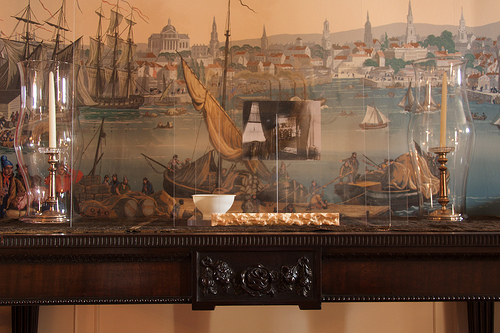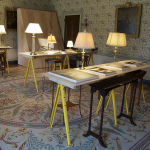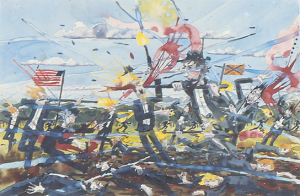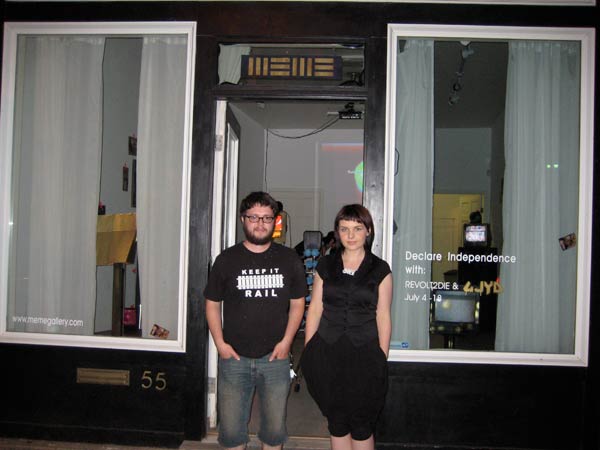The newest object in the Nightingale-Brown House collection was, until recently, their somewhat infamous Goddard “secretary” desk and bookcase. Adorned with ornate brass hardware and a formidable set of carved shells, this nine-and-a-half foot high cabinet–although it was built in 1993–is not exactly contemporary. It is in fact a stand-in, an exact replica of a piece from the 1790s that sat in the hands of the Brown family and the Nightingale house for 175 years. The original was made by a renowned Newport furniture maker and is one of only nine in the world (the RISD museum owns another). In 1989 it was auctioned for $12,100,000. Still the most expensive single piece of American furniture ever sold, its profits single-handedly rebuilt the then barely-standing house from inside out, and transformed this aging residence into a museum.
The Nightingale-Brown House’s usually static collection has again admitted some contemporary acquisitions. For the new exhibition “Art+History,” artists Jill Slosburg-Ackerman and Carla Herrera-Prats were each commissioned to create new works that use the house’s collection and history as their instigating reference. The exhibition was curated by students in the master’s in public humanities program, Meg Rotzel and Rosie Branson Gill.
As a historical house museum, the Nightingale-Brown House occupies a curious position. It is expected to speak both for a regional history and a national cultural heritage that reaches back to colonial America. But it does so through an exceedingly particular lens: a single home and the inherited collection of personal belongings that fill it. Unlike a conventional history museum, house museum collections are like a time capsule–a permanent set. And they are frequently treated as such, either painstakingly arranged to reconstruct an exact moment in time, like the Paul Revere House in Boston, or a comprehensive portrait of a particular figure in their daily life, as seen at the Walter Gropius house in Lincoln, MA.
Following neither of these conventions, the Nightingale-Brown House is decidedly more casual. The rooms have been redecorated to approximate the 1920s, yet the house’s curators didn’t attempt to literally recreate the home’s accurate arrangements in that decade; the date is more a theme than a rule. To pin down this house to a specific historical moment would simply not fit. Lived in until the 1970s, it was home to five continuous generations of the Brown family, which makes for nearly 200 years of family heirlooms and objects from a disjointed, two-century ancestry. One generation’s mementos are sandwiched and layered indiscriminately with the next; a worn, food-stained high chair faces a cabinet of 18th century china. Another Goddard desk, this one smaller and an original, sits comfortably in a not-quite pair beside the 1993 replica.
-
“Everywhere I look I see disjunctures,” remarked sculptor Jill Slosburg-Ackerman as she compared the finish on the two Goddard pieces. Their slightly inconsistent coloring, she suspected, might stem from changes in wood-drying processes over the centuries between their construction. Indeed, either an eye for detail or a connoisseur’s savvy are necessary to parse the lineage of the objects on display here. There are no labels clarifying dates, the materials or a creator. And velvet ropes–or those familiar ribbons tied over the seats of chairs to more delicately enforce a viewer’s safe distance–are noticeably absent.
As we walked through the large rooms of the house, the Boston-based artist was putting the finishing touches on her installation “Import-Export,” a set of sculptures she’s inconspicuously nested throughout the house. Much of the imagery in these works comes from the realm of design and domestic objects. Furniture and dishware, both found and handmade, are reoccurring characters, but in her combination of form and function, the usability of designed objects becomes a trope–implying repetitive daily use. It also alludes to repetition as the labor in mass production, though it is to an era of industrialization earlier than the present.
In girl with a hose an original china plate and its wooden stand, both taken from the collection, are married with a replica of the same plate stand, which sits empty and unstained behind them. Between the original and recreated objects is a photograph taken from the Brown Family Archives that shows the image alluded to in the piece’s title. The photograph is mounted on the face of a wooden plank whose surface is chiseled away, decoratively echoing the spraying water in the photograph. The carving, a motif she repeats in other works, is suggestive of both Japanese woodblock prints and the house’s former termite ridden decay.
Narratives of orientalism, colonialism and slavery are teased from the objects already in the house, and the work acts as a framing or display device. This is most evident in framing station, where a photograph–also from house’s archive–is suspended between several sheets of layered plexiglass. Large glass margins are left empty around the photograph, directing the viewer to hand-painted wallpaper behind that depicts a colonial New England harbor scene, complete with a number of slaves and American Indians.
But Slosburg-Ackerman’s tone is extremely conversational, a formal play and activation of contradictions in the space rather than a refusal of them. “It’s very much responding to the things I’ve learned about the place,” she said, “but then just forgetting it to some degree. The story is more my story.”
-
California-based artist Carla Herrera-Prats’ Keep the word vanishing until the end uses photography from the Brown Family Archives as a jumping-off point to explore the demise of commercial portraiture in the twentieth century. The archives house a wealth of professionally taken portraits of the Brown family, many by the most famous studios on the East coast. After the Great Depression, the number of formal family portraits in the collection wanes as they are supplanted by Polaroids and point-and-shoot photos taken by family members themselves, reflecting the disappearance of professional photography in the face of technological developments.
Herrera-Prats’ project is a detective-like hunt to find and document the physical locations of the studios that photographed the Brown family, as they are in present day. At the Nightingale-Brown House, she shows the resultant photographs from her search–a set of highly formal, frontal analog color photographs, reminiscent of the images that would have originally been shot in those spaces. A few of the most famous studios - like Bacharach in New York and Boston - are still in business, but most are completely gone and their locations repurposed. While several of the photographs show actual photography studios, one shows a church, another a Lord&Taylor department store and some are private residences. Rather than explaining anything more to us about the studios, all the photographs can tell us is that the businesses have been replaced.
Though Herrera-Prats poses as a historian, she makes it plain that her evidence is dubious. Because the names of city streets and numbers of addresses have varied over the years, the accuracy of final site is often speculative. She uses contact sheets as the labels for each ‘finished’ photograph of a space, showing discarded shots or other prospective sites, making it clear that the images she shows us are not facts but editorial choices. Though earnestly displaying the results of her investigation, she is not mastering a historian’s discourse,she is happily struggling.
-
When visiting “Art+History,” it is difficult not to think of site-specific institutional critique as it was practiced in to ’90s–namely the work of Mark Dion and Fred Wilson’s Mining the Museum. These artists worked within the museum’s administration, postured as amateur historians, curators and anthropologists to suggest alternative narratives that subverted the authority of ‘proper’ history as proposed by the institution. Later, art historian Miwon Kwon criticized these practices for the ease with which they were re-absorbed by the very museums they supposedly undermined. She wrote that these artists’ ability to tease out a minor history was not necessarily founded in the geographic location of the museum, but on the general exclusion and authority inherent to the very concept of a collection or museum. As the practice of illuminating a ‘minor’ history became a trademark service provided by these artists, it became movable to anywhere–and was used by museums as a marketing gimmick to bring the novelty of these alternative histories home.
The artists in “Art+History” are clearly influenced by these ideas. But while ’90s institutional critique artists pointed the finger at museums for hiding the darker elements of their collecting and administration, the artwork at the Nightingale-Brown house speaks for a more general and inevitable cultural oversight and forgetting–one caused not by suppression but by the buildup and accumulation of materials in the archive and their relative use values.
Despite all of this, the linkage to the earlier institutional critique work stems not so much from the artworks themselves, but the curatorial decision-making at work in the show. The question of audience remains though: who does the reintroduction of these concepts work for when their critical move has already been so dissected and absorbed? The fact that the curators have framed this project not as a contemporary art exhibition, but an educational device, is relevant here and may open the door for breathing new life into old ideas
- Installation shots of Art+History, Jill Slosburg-Ackerman (top) and Carla Herrera Prats (above).
Nightingale-Brown House
Art + History - WordPress
Art+History - Flickr
"Art+History" will be on view through October, 2009 at the Nightingale-Brown House, 357 Benefit St, Providence, RI.
All images by Nara Hernandez, and courtesy of the artists, and the Nightingale-Brown House.
This review was originally posted in the April 30th edition of The College Hill Independent






